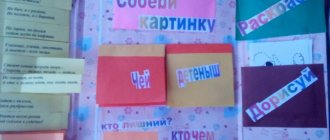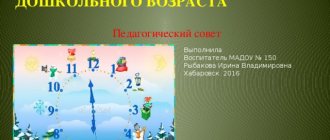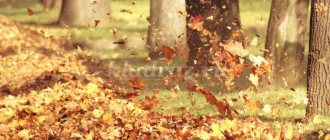A promising lesson plan in a corner of nature with children of the 2nd junior group
Tatiana Smirnova
A promising lesson plan in a corner of nature with children of the 2nd junior group
A long-term plan for activities in a corner of nature with children of the second junior group .
September
Topic: “Our beloved parrot”
(activity - observation)
Goal: to form children’s understanding of birds; learn to observe a parrot, highlight external signs, behavioral features and lifestyle. Compare a live bird (in the picture)
with a toy. Cultivate a caring attitude towards birds.
(Preschool education, No. 7 – 2005, p. 21)
Topic: “A house for a parrot”
(game - research)
Purpose: to introduce children to the structure of a parrot cage: paper is spread on the bottom; a feeder and drinking bowl are attached to the wall of the cage; There are two perches, a mirror, and chalk for the bird's beak. Learn to notice actions and name them, repeating after the teacher. Involve older children in cleaning the cage and feeding the parrot.
(Preschool education, No. 7 - 2005, p. 22)
Topic: “Apples for Bunny”
(integrated
lesson ) Purpose: to form children’s understanding of fruits; teach them to name them and highlight their external features, look at dummies of fruits, offer to make an apple for Bunny.
(E.V. Polozova, p. 98)
Topic: “Gingerbread cookies for Katya’s doll”
(game -
activity ) Purpose: to form children’s understanding of the properties of sand: dry - crumbles, rustles; wet sand - molds. You can make gingerbread cookies from wet sand (various molds, cups)
October
Topic: “House for the turtle Agashka”
(game -
activity ) Goal: to strengthen children’s ability to manipulate dry and wet sand; stimulate the imagination, manifestations of creativity; use molds and small spatulas for work.
(K. Belaya, p. 69)
Topic: “Golden Autumn!”
(integrated
lesson ) Purpose: to form children’s understanding of the signs of autumn: it’s cold, it’s raining, the leaves have turned yellow and are falling to the ground; introduce the nature ; examine the herbarium and suggest a group drawing of an autumn tree using foam rubber swabs.
(E.V. Polozova, p. 123)
Topic: “Collect tomatoes and store them for the winter!”
(integrated
lesson ) Purpose: to form children’s understanding of vegetables that grow in the garden (examination of illustrations, dummies)
;
learn to name vegetables, highlight their external characteristics (shape, color)
. Make a collective
applique “Pick tomatoes from the garden”
(V.V. Gerbova, p. 29)
Topic: “Golden fish”
(
lesson – observation ) Purpose: to form an initial idea of the structure of the fish (elongated body, head in front, tail in back, abdomen below)
; the fish is alive, swims, it must be fed with special food; learn to distinguish a live fish from a toy fish; cultivate a caring attitude towards fish.
(Preschool education, No. 7 – 2005, p. 16)
November
Topic: “Aquarium is a home for fish!”
(
lesson - research ) Purpose: to introduce children to the structure of an aquarium: the bottom is covered with multi-colored pebbles, wet sand, the stones are buried in the sand, they are also wet; There are algae in the aquarium, they are long and green. Involve older children in cleaning the aquarium.
(Preschool education, No. 7 – 2005, p. 18)
(In the afternoon, you can offer to draw algae, E.V. Polozova, p. p. 53)
Topic: “Building a house from stones for a Bunny”
(game -
activity ) Purpose: to introduce the properties of stones: hard, heavy, of different shapes and sizes. Compare a stone with foam rubber: what is lighter, what is heavier, what sinks in water, what floats. You can use them to build a house for a bunny. Invite children to use other natural materials : sticks, sand, etc.
(K. Belaya, p. 70)
Topic: “Acquaintance with indoor plants”
(
lesson - observation ) Purpose: to help children remember and correctly name parts of plants: leaves, trunk (for ficus, learn to distinguish and name a wide, large leaf and a narrow, long one;
cultivate a caring attitude towards flowers, involve older children in caring for leaves (wipe leaves, remove dry ones)
.
(V.V. Gerbova, p. 57)
Topic: “How plants drink water”
(game - experience)
Purpose: to give an idea that without water all living things die, plants dry out, lose leaves; after the soil is watered, it changes color and becomes dark; All living things love clean water; it cannot be polluted.
December
Topic: “Observing water in a fountain”
(
lesson - observation ) Purpose: to introduce the properties of water: flowing, gurgling, splashes flying, droplets dripping. Discuss the question of who needs water: children, fish, birds, plants. I wash my face and hands with water to keep them clean.
(Preschool education, No. 7 – 2005, p. 24)
Topic: “Winter – winter!”
(didactic game)
Purpose: to form children’s understanding of the signs of winter: it is very cold, the sun shines little, it is snowing; talk about possible actions with snow, look at the illustrations.
(K. Belaya, p. 79)
Topic: “Observing the Christmas tree”
(
lesson - observation ) Purpose: to introduce children to the Christmas tree (after examining it at the site)
: green, there is a trunk, branches with prickly small needles; compare a live Christmas tree branch with a toy one; consider illustrations, drawings; cultivate a caring attitude towards wood.
(Preschool education, No. 7 – 2005, p. 18)
Topic: “Games - fun with water”
Goal: to consolidate knowledge of the properties of water: clear, warm, cold; You can wash toys in it; heavy objects sink in water, light objects float on the surface; offer wind-up, floating toys for games.
(V.V. Gerbova, p. 44; Preschool education, No. 7 - 2005, p. 2)
January
Topic: “Snowflake visiting the children”
(didactic game)
Purpose: to form children’s understanding of the properties of snow: cold, white; You can make Easter cakes, pies, snowballs from snow; in a warm room the snow melts, and so does the snow in your hand; water can be made from snow. Fix the properties of water: cold, warm, tasteless, dirty, clean, tasty; its color is transparent, white, red, blue, etc. (K. White, p. 72)
Topic: “Great Helpers”
(game)
Purpose: to consolidate knowledge of the role of water: a person needs it, you can, for example, wash clothes and dresses for Katya’s doll in it; Indoor plants are watered with water, the ground becomes moist, and the plants drink this moisture from it.
Topic: “Games - experiments with water”
Goal: to continue to reinforce children’s knowledge that water is clear, but it can be colored any color or made dirty; that it tastes different from juice, milk and other liquids.
(Preschool education, No. 7 – 2005, p. 24)
Topic: “About a small drop!”
(game - fairy tale)
Purpose: to introduce children to the properties of water: warm, clear, cold, clean, dirty. Plants, animals, birds, fish, and people cannot live without water. Give children emotional pleasure from communicating with each other and playing with water. (K. Belaya, p. 76)
February
Topic: “Pets”
(integrated
lesson ) Purpose: to form children’s ideas about domestic animals, examining models and illustrations with images of domestic animals grazing in a meadow (cow, goat, horse)
;
consider a soft toy - a kitten and offer to draw its tracks (finger painting, group work)
(V. V. Gerbova, p. 116; E. V. Polozova, p. 35)
Topic: “Guinea pig”
(or hamster) (integrated
lesson ) Purpose: to introduce children to a living object - a guinea pig; highlight external signs, characteristics of behavior, nutrition; learn to distinguish between objects: hard and soft;
develop the ability to distinguish and name shapes; promote the development of auditory attention; learn how to make carrots for toy animals.
(E.V. Polozova, p. 45)
Topic: “House for a guinea pig”
(research game)
Purpose: to introduce children to the structure of a cage for a guinea pig: sawdust spreads to the bottom, there is a special drinking bowl and feeder. The cage is large and long, it needs to be cleaned once a week. Reinforce knowledge about what a guinea pig eats and invite children to feed it.
Topic: “Name the baby!”
(didactic game)
Purpose: to form children’s idea that animals have cubs; teach them to name them and find their mother for each baby (pets)
. Fix the names of pets and their characteristics.
March
Topic: “Treats for Mother’s Day!”
(games with sand)
Purpose: to consolidate knowledge of the properties of sand: dry, free-flowing, wet, moldable. Learn to make pies for mom using molds, spatulas and a variety of natural materials : pebbles, sticks, walnut shells, pumpkin seeds.
Remember the song “I bake, bake, bake!”
Topic: “How twigs drink water”
(observation)
Purpose: explain that a branch of a tree or flower
(Chinese rose)
alive, drinking water, leaves blooming on it. Remember the rules for caring for indoor plants.
(V.V. Gerbova, p. 57)
Topic: “In the poultry yard”
(integrated
lesson ) Purpose: to form children’s understanding of poultry; learn to name and distinguish birds and their young; form correct sound pronunciation;
suggest drawing a cockerel using the “monotype”
.
(E.V. Polozova, p. 50)
Topic: “Spring has come to visit us!”
(cognitive
lesson ) Purpose: to introduce children to the signs of spring: the snow has melted, streams are running, it has become warmer, the sun is shining brighter, birds are chirping.
Examination of illustrations with signs of spring and comparison with winter illustrations.
April
Topic: “We plant green onions!”
(
lesson – research ) Purpose: to form children’s understanding of how to plant onions correctly and what equipment is needed (a box with soil, a shovel, a watering can with water)
.
Talk about the properties of “earth”
: dark, loose, dirty, dry - crumbling. All plants grow in the ground.
Invite older children to try planting onions themselves.
Topic: “Onion Observation”
Goal: to introduce children to the conditions necessary for the successful growth of green onions: water, light, heat.
Talk about the beneficial properties of onions.
Continue to monitor the sprouting of the onions, noting minor changes.
Offer to draw a bow (green pencils)
.
Topic: “Wild animals”
(cognitive
lesson ) Purpose: to form children’s understanding of wild animals, how they differ from domestic ones.
Looking at pictures and illustrations of animals.
Learn to identify external features and correctly name their babies.
Topic: “Firewood for the Hedgehog”
(integrated
lesson ) Purpose: to introduce children to the forest animal - the hedgehog. Talk about his external signs and behavioral characteristics.
Learn to name and distinguish natural materials : cones, nuts, sticks. Compare sticks with each other: thick - thin, long - short.
Offer to make firewood for the hedgehog.
(E.V. Polozova, p. 43)
May
Topic: “Beauty Butterfly”
(game - research)
Purpose: to form children’s understanding of insects, how they differ from animals and birds.
Introduce the butterfly, examine its external signs (two wings, body, antennae, feeding habits, trace its life path.
Draw children's attention to the variety of butterflies and the difference in their patterns.
(collective work “Let’s decorate the wings of a butterfly”
- finger painting)
Topic: “The cheerful sun better shine on us!”
(game -
activity ) Purpose: to tell children about the sun, about its benefits for all life on earth.
Look at the sun in the picture: round, yellow, warm, hot, bright.
Note at what time of year the sun shines longer and brighter. Learn a nursery rhyme about the sun.
Invite the children to draw the sun with sticks on the sand.
Topic: “Fluffy dandelions”
(observation)
Purpose: to introduce the plant, tell its name, highlight its characteristic features (yellow, fluffy flower, long, smooth stem)
.
Show the transformation of yellow dandelion flowers into fluffy balls. (Preschool education No. 7 - 2005, p. 25)
Topic:
“We’ll pick strawberries!”
(didactic game)
Purpose: to form children’s understanding of berries, teach them to distinguish and name some of them (blackberries, blueberries, strawberries, etc.)
Draw children's attention to strawberries, their shape, size, color, taste.
Offer a didactic game “Collect strawberries in baskets”
.



